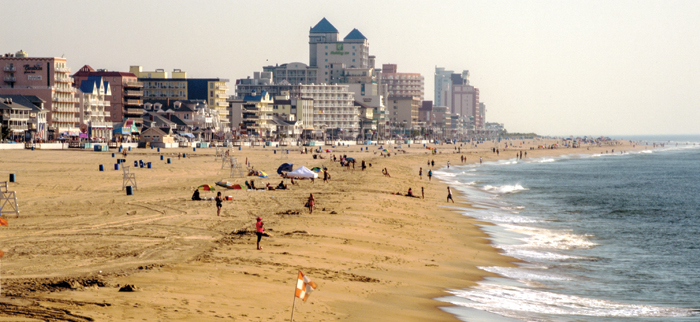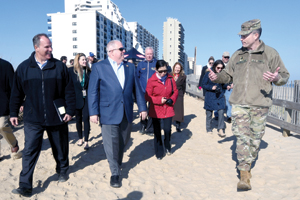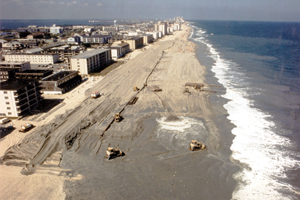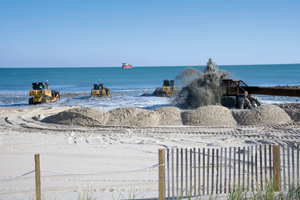Shoring Up Ocean City: Beach renourishment prevents storm damage

Ocean City; by Joseph H. Soares, Jr.
Each year, millions of visitors from throughout the United States come to enjoy the famous beach in Ocean City, Maryland.
Most have no idea that the prime attraction of this tourism hot spot is actually a project engineered to protect the city from powerful coastal storms and hurricanes.

Secretary Belton, Gov. Hogan, Col. Chamberlayne and others tour the project in November; by Joe Andrucyk
Berm and boardwalk
The beach at Ocean City is one element of a coastal storm risk management project—the Atlantic Coast of Maryland Shoreline Protection Project—designed and constructed through a partnership between the U.S. Army Corps of Engineers (Baltimore District), Maryland Department of Natural Resources, Worcester County and Town of Ocean City.
While the project was initially completed in 1994, it does need maintenance, including periodic renourishment of the beach—every four years or so. This fall and winter, crews will be pumping roughly 900,000 cubic yards of sand on the beach to restore the engineered beach berm to its full design elevation.
“This renourishment is an important part of the long-term commitment to maintaining this coastal storm risk management project,” says Baltimore District Project Manager Justin Callahan, who has worked on the project in various capacities since the late 1990s, eventually becoming the project manager in 2013.
The authorized project consists of improvements to the beach as well as to the boardwalk. The berm element being renourished is a 100-foot-wide beach berm elevated to 8.5 feet above the National Geodetic Vertical Datum—a standard used for coastal construction that’s similar to mean sea level. The berm stretches along the entire project area, from the Maryland-Delaware line to Third Street near the inlet. The small area further south naturally accretes sand, and there is a wide beach there.
From Fourth Street north to 27th Street, where the boardwalk ends, a 14.5-foot-high steel sheet piling bulkhead with a concrete cap was constructed along the oceanward edge of the boardwalk. From the end of the boardwalk north, a 14.5-foot-high dune with a 25-foot-wide crest at the top backstops the constructed beach berm up to the state line. The dune is reinforced with plantings and has more than 200 dune crossings.

Sand pumped onto the beach in 1991 as part of initial construction of the berm and dune; Army Corps photo
Natural movement
Initial construction on all elements was completed in 1994, including repairs from two significant storms during construction. The project includes the authority for periodic renourishment as needed, which on average, comes to about 800,000 cubic yards of sand every four years. While Callahan noted the project loses an average of 175,000 cubic yards of material a year, he said the project is resilient against the larger storms that occasionally come along.
“The project itself does a relatively good job of repairing itself,” Callahan said. “You can go out there the week after a storm and you can measure and see that there are horrific sand losses to the dune and the beach berm.
“But, what we also see is that most of that sand is drug right offshore and its sitting there on a big sand bar just beyond the beach. The wave attack pulls the sand out to the ocean, but it doesn’t take it too far away, and then normal wave action pushes it back up on shore again.”
The project today
To date, based solely on major storms that have struck Ocean City since initial work was substantially completed, the Corps estimates that roughly $927 million in damages have been prevented. That includes damages prevented during the storms that impacted the project before construction being considered fully complete. Additionally, that figure does not reflect the benefits of protection from smaller nor’easters and other smaller storms.
Some of the major storms taken into account include the November 2009 “Nor’Ida” storm—a combination of a nor’easter and the remnants of Hurricane Ida—as well as Hurricane Irene in 2011 and Hurricane Sandy in 2012.
Superstorm defense City Engineer Terry McGean recalls the 2011 storm that came at the height of his town’s busy summer season.
“With Hurricane Irene, Ocean City was literally in the eye of the storm, bringing 60 mile-per-hour winds and 20-foot seas. The storm event that we had been warned would wipe out Ocean City had arrived,” said McGean. “Expecting the worst, we successfully evacuated the town. When the sun came up Sunday morning, I sent out our damage assessment teams. Instead of toppled buildings and destroyed infrastructure, we found some loose siding and a pothole in a city parking lot. By noon, our businesses were open, and we had one of the busiest Labor Day weekends in years.” McGean praised the project and the partnership with the Corps, highlighting the benefits to Ocean City over the years.

Progress on the project today; by Joe Andrucyk
“Since the completion of the project, there have been no structural damages from ocean flooding, and, more importantly, there have been no injuries or deaths from storms,” McGean said.
In January 2016, a vicious nor’easter known as Winter Storm Jonas hit the area hard, striking as a “70-year” storm and removing an estimated 900,000 cubic yards of sand from the beach project. As noted earlier, though, much of that sand was just offshore and over time has returned to the shoreline. The project performed as designed and prevented an estimated $200 million in damages to property, though the project itself suffered significant damage to the dunes and beach berm.
Working closely with the State of Maryland and the Town of Ocean City, Corps personnel inspected the damage to the project from the storm and began incorporating the storm’s impacts into plans for this year’s renourishment.
Risk reduction
As the Town of Ocean City has already completed work to restore impacts to the dunes from Jonas, the fall and winter renourishment work is focused on restoring the wide flat berm to its authorized dimensions, so it can continue to work in concert with the dune and bulkhead systems to reduce risks.
Callahan noted that he is proud to be able to work on a project that helps reduce risk to Ocean City from coastal storms, by helping to preserve the town that’s not only an economic driver for the region, but a cultural icon for Marylanders and others nearby. “If you grew up around here,” Callahan said, “Ocean City is summer.”
Article by Chris Gardner—U.S. Army Corps of Engineers, Baltimore district public affairs specialist. Appears in Vol. 21, No. 1 of the Maryland Natural Resource magazine, winter 2018.


 1-888-373-7888
1-888-373-7888 233733
233733